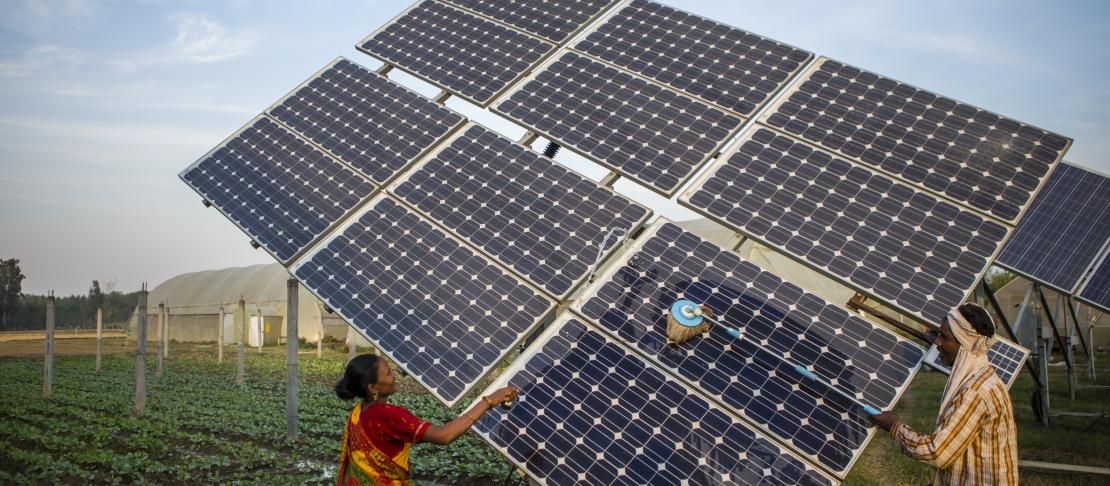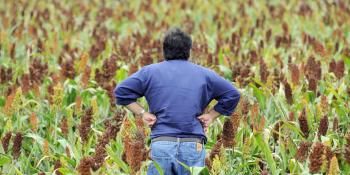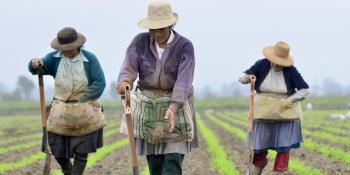Kickstarting India’s multi-billion dollar solar irrigation scheme

A multi-stakeholder policy consultation assesses the best way forward for implementing a scheme to promote solar farming in India
“Irrigation generates one to two jobs per hectare,” said Mr. Sompal Singh Shastri, former Minister of State for Agriculture and member of the Planning Commission of the Government of India. He was speaking at a recent policy dialogue organized by the International Water Management Institute (IWMI) on the Kisan Urja Suraksha Evam Utthaan Mahaabhiyan (KUSUM) scheme. KUSUM is a multi-billion dollar initiative by the Indian government, announced during the budget session earlier this year, to promote solar farming in India. Under the scheme, the government will provide 2.75 million solar pumps to farmers. During the first phase, 1.75 million solar pumps will be installed in places without grids and 1 million in places with grid availability. The scheme also envisages 50,000 grid-connected tube-wells/lift irrigation and drinking water projects.
Trailblazers for farmer-led solar farming
The announcement of the scheme has been a point of validation for the researchers at IWMI and the CGIAR Research Program on Climate Change, Agriculture and Food Security (CCAFS). Together with support from Tata Trust and the CGIAR Research Program on Water, Land and Ecosystems (WLE), they set up the first-ever solar pump irrigator’s cooperative in Dhundi Village in Gujarat. The encouraging results from this first-of-a-kind cooperative model was acclaimed widely by state- and national-level policy makers. The model was presented to the Finance Minister during pre-budget consultations with experts in the agriculture sector, to elaborate on its benefits in terms of scaling. The Prime Minister of India was also briefed on the success of this pilot during a consultation alongside eminent economists, the fruits of which were manifested in the form of the KUSUM launch.
Learning from one another
A well designed KUSUM policy is important for India to secure sustainable development of agriculture, maintain food security and safeguard groundwater during times of changing climatic conditions."
Diego Senoner, Technical Expert, Indo-German Energy Program
The diverse agro-ecology of the nation and differential ground water availability call for heightened deliberations about the way forward for pan-India implementation of KUSUM. Thus a policy dialogue was instituted. Keeping in mind India’s energy divide as well as the diversity of contexts, which overrule the possibility of having one single model of solar irrigation, the forum was designed as a multi-stakeholder platform. It brought together members from the government, academia, international development agencies, and others, who presented the multiple models of solar irrigation already in operation in various pilot modes across different states in the country like Gujarat, Rajasthan, and Maharashtra as well as states from East India.
Assessing the findings from the locally-contextualized pilots helps in not only
The elements of joint liability, ownership, mutual assistance and sustainability makes the cooperative approach a promising one for scaling across states in India
streamlining implementation options and scaling pathways but also leads to more precise resource mobilization. For instance, in the state of Rajasthan, the solar pump pilots in certain areas reveal that they are highly profitable in diesel using districts. Therefore, the government can specifically target the small farmers for subsidies in such districts. Wealthier farmers can likely go without subsidies, due to the high cost reductions from solar pump adoption.
The "cooperative" approach was highlighted by the representatives from the National Dairy Development Board for the states of Punjab and Maharashtra, and by IWMI researchers for Gujarat. While the former shared knowledge on feeder-level pilots with grid-connected dairy farmers, the latter offered information about the Dhundi model. In the Dhundi model, solar power is being harnessed as a "remunerative crop." in order to attain the multiple benefits of: increasing crop intensity; lowering carbon footprints; sustainable ground water use; and additional income generation by power sales to local utility, all channelled through a farmer’s cooperative.
The elements of joint liability, ownership, mutual assistance and sustainability makes the cooperative approach a promising one for scaling across states in India. The idea of simultaneous operation of multiple service delivery models (asset sharing model, asset sharing through bank finance, enterprise-based portable solar pumps, micro pumps for marginal farmers, etc.) within the same location was put forward by the German Development Agency, who illustrated case studies from the Eastern Indian states of Bihar and West Bengal.
Kickstarting KUSUM
Given the multitude of options currently available and operational in the country, there was common consensus during the consultation that there is no "silver-bullet" approach to implementing a pan-India solar irrigation scheme. However, there are several pointers that can be taken into account to make KUSUM attractive to the millions of farmers across the country. Researchers from IWMI underscored the importance of factors like easy enrollment and uptake, attractive return on investment and hassle-free operation for encouraging uptake of a solar irrigation scheme. The benefits accruing to the grid farmers, as in the Dhundi cooperative in Gujarat, can be communicated widely, highlighting the advantages of reliable, day-time power, better cash crops and improved climate resilience.
Some of the key recommendations put forward by IWMI for facilitating the scheme and improving the ‘energy-irrigation nexus’ in the nation are: solarizing existing pumps rather than adding new ones; solarizing all farmers on a Feeder instead of a few; undertaking capacity building of farmers; and promote institution building, among others.
Shehnab Sahin is the Communications Specialist at CCAFS South Asia



